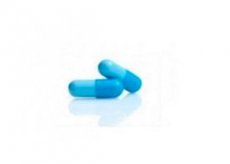Medical expert of the article
New publications
Preparations
Sodium bicarbonate
Last reviewed: 03.07.2025

All iLive content is medically reviewed or fact checked to ensure as much factual accuracy as possible.
We have strict sourcing guidelines and only link to reputable media sites, academic research institutions and, whenever possible, medically peer reviewed studies. Note that the numbers in parentheses ([1], [2], etc.) are clickable links to these studies.
If you feel that any of our content is inaccurate, out-of-date, or otherwise questionable, please select it and press Ctrl + Enter.

Indications Sodium bicarbonate
It is used for uncompensated metabolic acidosis in poisonings of various origins, and also in complications after surgery, deep or large burns and shock. It is also used for prolonged diarrhea, diabetic coma, persistent vomiting, severe forms of kidney/liver disease, acute and profuse blood loss, as well as severe hypoxia in newborns and prolonged fever.
The drug is administered without fail if the patient has a decrease in blood pH to values below 7.2 (in a normal state it should be 7.37-7.42).
Pharmacodynamics
The medicine helps to stabilize the alkaline blood levels and correct metabolic acidosis. During the dissociation of the active substance, the bicarbonate anion is released, which is synthesized with hydrogen ions, resulting in the formation of a carboxylic acid, which further decomposes to the state of water with carbon dioxide released during breathing.
A solution with a pH level of 7.7-7.9 prevents the possibility of sudden alkalinization and also promotes a smooth change in acidosis, while simultaneously increasing the alkaline reserves of the blood.
At the same time, the drug increases the excretion of chloride and sodium ions from the body, increases the osmotic form of diuresis, helps alkalize urine and prevents the appearance of uric acid as a sediment inside the urinary system. Bicarbonate anion is not able to pass into cells.
Dosing and administration
For adults, the solution is prescribed either in rectal drip form or by intravenous injection, and for children - by intravenous drip method. Taking into account the severity of the developed acidosis, the medicine can be diluted with a 5% glucose solution (ratio 1 to 1).
Intravenous injection for adults should be performed at a rate of about 60 drops/minute, and should not exceed 200 ml/day. The dose size should be calculated taking into account the level of blood gases using the following formula:
The volume of 0.5 molar sodium bicarbonate (buffer) 4.2%, calculated in ml, is equal to the base deficit (-BE value) multiplied by the patient's kg weight, also multiplied by 0.3 x 2 (the value 0.3 is the proportion of extracellular fluid in relation to the total fluid level).
For children over 1 year of age, the solution is prescribed in a dose of 5-7 ml/kg of weight.
The maximum permissible adult daily dose of the drug is 300 ml (if the patient is overweight, then 400 ml) per day. A child can be administered within 100-200 ml of the solution per day (depending on weight).
Use Sodium bicarbonate during pregnancy
There is no information on the use of the solution during lactation/pregnancy. The drug is allowed to be prescribed only in cases where the probable benefit to the woman will exceed the risk of complications for the fetus.
The use of the solution during breastfeeding is permitted only in cases of life-threatening disorders.
Side effects Sodium bicarbonate
The main side effects are vomiting with nausea, as well as headaches and stomach pains, anxiety, anorexia, seizures, increased blood pressure and alkalosis.
 [ 17 ]
[ 17 ]
Overdose
As a result of drug poisoning, hypernatremia, hyperalkalosis, as well as tetanic seizures and hyperosmia may occur.
If the victim exhibits symptoms of alkalosis (convulsions develop (also with signs of tetany), a feeling of excitement, an increase in pH and sodium, and a decrease in calcium and potassium), it is necessary to stop the injection of the solution. Then, if necessary, administer a glucose solution (5%) or sodium chloride.
If there is a risk of tetany, an adult should be given an intravenous injection of calcium gluconate (1-3 g).
Interactions with other drugs
Attention!
To simplify the perception of information, this instruction for use of the drug "Sodium bicarbonate" translated and presented in a special form on the basis of the official instructions for medical use of the drug. Before use read the annotation that came directly to medicines.
Description provided for informational purposes and is not a guide to self-healing. The need for this drug, the purpose of the treatment regimen, methods and dose of the drug is determined solely by the attending physician. Self-medication is dangerous for your health.

